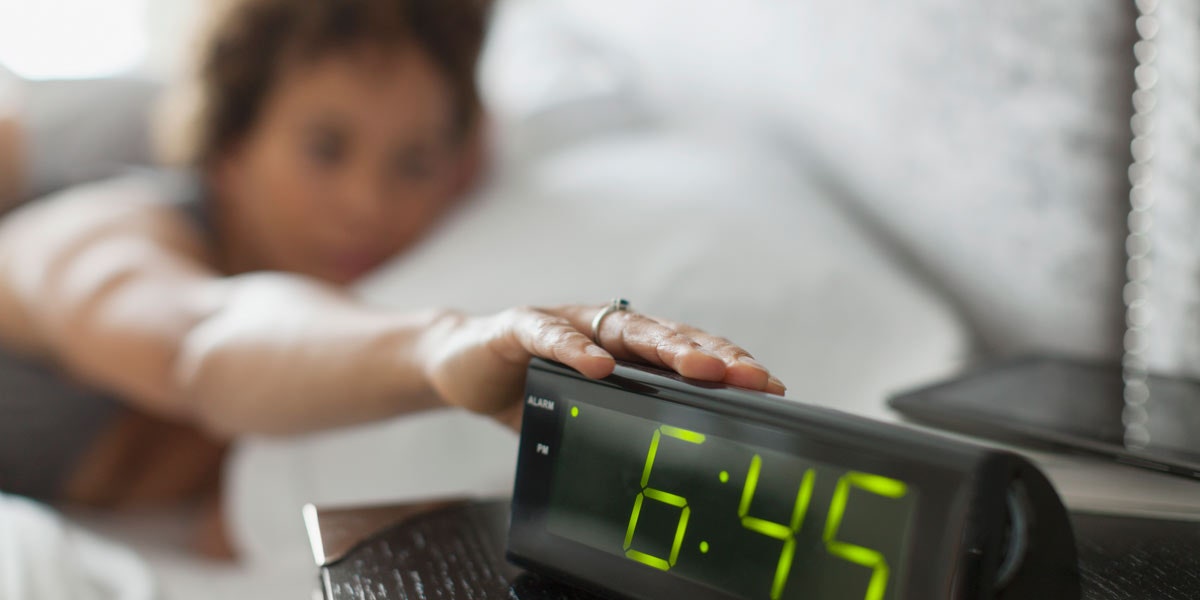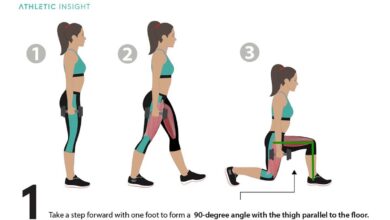
Stop Snoozing, Start Your Morning Workout
How to stop snoozing through your morning workout? It’s a common struggle, but one that can be overcome with the right strategies. We all know the feeling – the alarm clock screams, you hit snooze, and before you know it, you’re rushing out the door with barely enough time for a coffee, let alone a workout.
But what if there was a way to break free from the snooze button and start your day with a burst of energy and a sense of accomplishment? This guide will explore the reasons behind our snooze habit and offer practical solutions to help you conquer the urge to hit snooze and start your day with a healthy, energizing workout.
The key lies in understanding the biological and psychological factors that contribute to snoozing, setting realistic expectations for your morning routine, and implementing strategies to overcome the temptation to hit that snooze button. We’ll delve into the benefits of a consistent morning routine, the power of mindfulness, and the importance of finding accountability partners to keep you motivated.
By the end of this guide, you’ll be equipped with the tools and knowledge to create a morning routine that fuels your fitness goals and sets you up for a successful day.
Understanding the Snooze Habit
We all know the feeling: the alarm blares, you hit snooze, and then repeat the process a few more times before finally dragging yourself out of bed. But why do we do it? What’s the science behind this seemingly harmless habit?
Biological Factors Contributing to Snoozing
The urge to hit snooze is partly rooted in our biology. When we wake up, our bodies haven’t fully transitioned from sleep mode to wakefulness. This transition takes time, and the initial awakening can be jarring. Our brains haven’t fully processed the signals from our alarm, and we may still be experiencing the remnants of deep sleep.
This creates a feeling of grogginess and a desire to fall back into sleep.
Psychological Factors Contributing to Snoozing
Beyond biology, our psychology plays a significant role in our snooze habits. We often hit snooze because we’re trying to avoid the unpleasantness of waking up. We may be dreading the day ahead, or simply not feeling ready to face the world.
This fear of the unknown can lead us to seek the comfort of sleep, even if it’s just for a few more minutes.
Effects of Snoozing on Sleep Quality and Workout Performance
Snoozing may seem harmless, but it can actually disrupt our sleep and hinder our workout performance. Those extra minutes of sleep can lead to fragmented sleep, which is less restorative than a single block of sleep. This can result in feeling tired and sluggish throughout the day, impacting our motivation to exercise.
The key to conquering that snooze button is to make your morning workout a priority. Set your alarm for a time that allows you to get a good workout in before your day starts, and resist the urge to hit snooze.
If you truly feel like you don’t have time, maybe check out what to do if you don’t have time to exercise for some ideas. But trust me, once you start incorporating exercise into your mornings, you’ll feel energized and ready to tackle anything the day throws at you!
Furthermore, snoozing can disrupt our circadian rhythm, the natural sleep-wake cycle that regulates our body’s internal clock. This disruption can make it harder to fall asleep at night, leading to a vicious cycle of poor sleep and snoozing.
Setting Realistic Expectations

The key to sticking to a morning workout routine is setting realistic expectations. If you’re trying to overhaul your sleep schedule and fitness goals simultaneously, you might set yourself up for failure. It’s better to start small and gradually increase the intensity and duration of your workouts as you build momentum and confidence.
Designing a Morning Workout Routine
Creating a morning workout routine that aligns with your sleep schedule and fitness goals is crucial. Consider your current sleep patterns and how much time you’re willing to dedicate to exercise. It’s essential to choose a workout that feels enjoyable and motivating.
We all know that feeling – the alarm clock screams, and our bodies just want to hit snooze. But instead of giving in, try thinking about the amazing benefits of a morning workout. It can be a powerful stress reliever, and sometimes, a little stress is exactly what we need to get going! If you’re feeling overwhelmed, check out this article on 8 quick ways to reduce stress right now.
Once you’ve taken a few minutes to de-stress, you’ll be ready to tackle your morning workout and start your day off right.
- Start with a short workout, such as a 15-minute walk or a 10-minute yoga session. Gradually increase the duration and intensity as you get comfortable.
- Choose a workout that you genuinely enjoy. If you don’t enjoy it, you’re less likely to stick with it.
- Schedule your workout at a time when you’re most likely to be successful. For example, if you’re a morning person, try working out before breakfast. If you’re a night owl, try working out in the evening.
Sample Workout Routines
Here are some sample workout routines tailored for beginners and experienced individuals.
Beginner Workout Routine
This routine is designed for individuals new to exercise.
- Warm-up: 5 minutes of light cardio, such as jogging in place or jumping jacks.
- Workout: 10 minutes of bodyweight exercises, such as squats, lunges, and push-ups.
- Cool-down: 5 minutes of stretching.
Experienced Workout Routine
This routine is designed for individuals who are already physically active.
- Warm-up: 10 minutes of dynamic stretching, such as arm circles and leg swings.
- Workout: 30 minutes of high-intensity interval training (HIIT), such as burpees, mountain climbers, and jumping jacks.
- Cool-down: 10 minutes of static stretching.
Strategies for Overcoming Snoozing: How To Stop Snoozing Through Your Morning Workout
Now that you understand why you snooze and have realistic expectations, let’s dive into strategies to conquer the snooze button. It’s about creating an environment that supports waking up feeling refreshed and ready to tackle your workout.
Setting an Effective Alarm
A well-placed alarm can be your secret weapon against snoozing. Here’s how to make it work for you:
- Place it Far Away:The extra effort to physically get up and turn it off is a good deterrent against hitting snooze.
- Use a Gradual Alarm:Instead of a jarring sound, consider an alarm that gradually increases in volume, mimicking a natural sunrise. This gives your body time to adjust to waking up.
- Vary Your Alarm Sounds:If you use the same alarm sound every day, your body can become accustomed to it, making it less effective. Try switching between different sounds, or even using a different alarm clock altogether.
- Use a Light Alarm:Light alarms simulate sunrise, prompting your body to wake up naturally. They are particularly helpful for people who struggle with seasonal affective disorder (SAD).
Monitoring Sleep Patterns with a Sleep Tracker
Sleep trackers offer valuable insights into your sleep patterns, allowing you to identify potential issues and make adjustments.
- Identify Sleep Trends:Tracking your sleep helps you understand your sleep cycles, identifying patterns like how long it takes you to fall asleep, how many times you wake up during the night, and your overall sleep duration. This information can be crucial in identifying potential causes of snoozing.
Sometimes, the thought of hitting the gym first thing in the morning can feel like a daunting task, especially if you’re battling anxiety. Learning to identify and manage different types of anxiety, like generalized anxiety disorder or social anxiety, can be a game-changer for your mental and physical well-being.
Understanding the common types of anxiety and how to cope can empower you to take control of your mornings and conquer that snooze button for a more energized and fulfilling day.
- Set Realistic Sleep Goals:Based on your sleep tracker data, you can set realistic sleep goals and adjust your bedtime or wake-up time accordingly.
- Improve Sleep Quality:By monitoring your sleep quality, you can identify factors that might be disrupting your sleep, such as inconsistent sleep schedules, caffeine consumption, or a noisy environment.
Mindfulness and Meditation for Morning Alertness, How to stop snoozing through your morning workout
Mindfulness and meditation practices can help you wake up feeling calmer and more focused, setting the stage for a productive workout.
- Start with Simple Breathing Exercises:Deep, slow breaths can help calm your nervous system and improve your alertness. Start with a few minutes of deep breathing before getting out of bed.
- Practice Mindful Stretching:Gentle stretches can help wake up your muscles and improve blood flow, leading to increased energy and alertness.
- Engage in Mindful Activities:Take a few moments to appreciate the present moment. Notice the sounds, sights, and sensations around you. This can help you feel more grounded and present, reducing the urge to hit snooze.
Creating a Motivating Morning Routine

A consistent morning routine can significantly impact your sleep and workout habits. It sets the tone for your day and helps you establish a rhythm that promotes both physical and mental well-being. By structuring your mornings, you create a predictable framework that supports your goals, making it easier to stick to your exercise plan.
The Impact of a Consistent Morning Routine
A consistent morning routine can improve sleep quality by establishing a regular sleep-wake cycle. This regularity helps synchronize your body’s internal clock, known as the circadian rhythm, with the natural light-dark cycle. As a result, you’re more likely to fall asleep easily and wake up feeling refreshed.
- Improved Sleep Quality:A consistent routine helps regulate your body’s natural sleep-wake cycle, leading to better sleep quality and easier waking.
- Reduced Stress:By having a structured morning, you eliminate the need to make decisions and reduce the stress associated with rushing and feeling overwhelmed.
- Increased Productivity:A calm and focused start to the day sets you up for a more productive and successful day.
Examples of Successful Morning Routines
Here are some examples of successful morning routines that prioritize exercise and other healthy habits:
- The Early Bird:
- Wake up at 6:00 AM.
- Drink a glass of water.
- Engage in a 30-minute workout (yoga, running, or strength training).
- Enjoy a healthy breakfast.
- Meditate for 10 minutes.
- The Balanced Routine:
- Wake up at 7:00 AM.
- Drink a glass of water.
- Prepare a healthy breakfast while listening to a podcast.
- Engage in a 20-minute workout (yoga, running, or strength training).
- Shower and get ready for the day.
Creating a Personalized Morning Routine
Here’s a checklist to help you establish a personalized morning routine that fits your lifestyle and goals:
- Determine Your Ideal Wake-Up Time:Consider your sleep needs and work schedule to find a realistic wake-up time that allows for a sufficient amount of sleep.
- Identify Your Priorities:What are your main goals for the morning? Do you want to exercise, meditate, or focus on healthy eating?
- Plan Your Activities:Based on your priorities, schedule your activities in a logical order. For example, if you want to exercise first, plan your workout before breakfast.
- Set Realistic Expectations:Start with a simple routine and gradually add more activities as you become comfortable. Don’t try to do too much at once.
- Be Consistent:The key to success is consistency. Stick to your routine as much as possible, even on weekends.
- Track Your Progress:Monitor your sleep quality, energy levels, and overall well-being to see how your morning routine is impacting your life.
Strategies for Staying Consistent
Sticking to your morning workout routine can be challenging, especially when faced with various obstacles. This section provides practical strategies for overcoming common hurdles and maintaining consistency.
Overcoming Common Obstacles
Obstacles can derail your morning workout plans. Identifying and overcoming them is crucial for staying consistent. Here are some common obstacles and solutions:
- Lack of Time:Evenings are often jam-packed with commitments. Prioritize your workout by scheduling it like any other important appointment. Set a realistic time, even if it’s just 15 minutes, and stick to it.
- Fatigue:Mornings can be tough, especially if you’re tired. Consider adjusting your bedtime to ensure you get enough sleep. Also, try a quick 5-minute warm-up before your workout to boost energy levels.
- Motivation:It’s easy to skip workouts when you’re not feeling motivated. Create a playlist of energizing music, or find a workout buddy to keep you accountable.
- Weather:Rain, snow, or extreme heat can make it challenging to get outside. Have a backup plan, like indoor workouts or online fitness classes.
- Injuries:Injuries can happen, but don’t let them derail your progress. Consult a healthcare professional and consider low-impact activities like swimming or cycling.
Finding Accountability Partners
Accountability is key to staying consistent. A workout buddy can provide support and motivation, making it more likely that you’ll stick to your routine.
- Benefits of Accountability Partners:Having a workout buddy offers numerous advantages. It provides social support, reduces the likelihood of skipping workouts, and adds a competitive element.
- Finding a Partner:Look for someone with similar fitness goals and schedules. You can join a gym class, ask friends, or use online fitness communities.
- Maintaining Accountability:Set clear expectations with your partner. Schedule regular workouts, check in with each other, and hold each other accountable.
Reward Systems for Celebrating Milestones
Rewarding yourself for reaching milestones is an excellent way to stay motivated and celebrate your progress.
- Setting Goals:Define achievable goals, like working out three times a week for a month.
- Choosing Rewards:Select rewards that are meaningful and motivating. It could be a new workout outfit, a massage, or a weekend getaway.
- Rewarding Progress:Celebrate your achievements, no matter how small. Recognize your effort and commitment.
Final Wrap-Up
Conquering the snooze button and establishing a consistent morning workout routine can be a transformative experience. It’s not just about fitting exercise into your day; it’s about creating a healthier, more energized you. By understanding the science behind snoozing, setting realistic expectations, and embracing strategies for staying motivated, you can unlock the power of a morning workout and reap the countless benefits it offers.
So, ditch the snooze button, embrace the morning, and let your workout become a catalyst for a more fulfilling and vibrant life.






